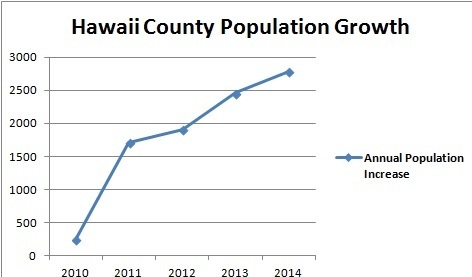When it comes to population increases in Hawaii County, more of us flew here than grew here, according to the latest data released Wednesday by the U.S. Census Bureau.
Hawaii County’s population grew 4.9 percent, to 194,190 people, according to the data that tabulated births and deaths and estimated domestic and international migration between the 2010 census and June 30, 2014.
The state as a whole grew 4.4 percent, while Maui and Kauai, with smaller population bases, grew more than 5 percent, the latest estimate shows. The United States as a whole, meanwhile, grew an estimated 3.3 percent.
Hawaii County led the state in the rate it grew this past year, according to the figures. Hawaii County’s population jumped 1.5 percent between 2013 and 2014, compared to 0.75 percent statewide.
“I don’t blame everybody wanting to move to Hawaii Island,” said Mayor Billy Kenoi. “It’s not surprising that we’d have a population increase.”
While Kenoi said he’s not familiar with the demographics of the new residents, he attributes the county’s growth in part to affordable housing.
“Our island remains one of the last places (in Hawaii) where working families can afford to own their own home,” Kenoi said.
Hawaii seems to be following a long, steady growth trend, said Eugene Tian, administrator of the Research and Economic Analysis Division of the state Department of Business, Economic Development and Tourism.
“The neighbor islands are growing at a faster rate than Oahu, and the state is growing at a faster rate than the United States,” Tian said.
The state as a whole gained 10,574 new residents between 2013 and July 1, 2014. Of those, 2,781 settled on the Big Island.
The numbers are important. The federal government uses census data when it distributes more than $400 billion in federal funds each year. Local governments use the numbers to determine where to build roads, new schools and allocate community services.
Of the 9,111 new residents on the Big Island in the past four years, 3,723 are the result of natural population changes, that is the number of births minus the number of deaths.
Another 3,087 moved here from other countries and 2,163 came from within the United States, including elsewhere in Hawaii. The Census Bureau was unable to categorize the remaining 138 people in its population estimate.
Tian said he felt most confident about the births and deaths data because they are sent to the Census Bureau by the state Department of Health. The migration figures, on the other hand, are estimated by the Census Bureau based on allocations.
Tian thinks the dramatic decreases in domestic migration shown for Oahu will be modified in upcoming census releases. He said those figures, showing a net loss of 15,248 people on Oahu from migration, are compiled from income tax returns and the movement of military.
Data from the U.S. Department of Defense for 2014, on the other hand, shows troops stationed in Hawaii are at a post-World War II high, he said.






